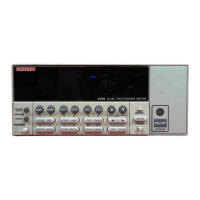15-6 Common Commands Models 2500 and 2502 User’s Manual
*TRG programming example
The command sequence in Table 15-4 configures the Model 2500 to be controlled by bus
triggers. The last command, which sends a bus trigger, triggers one measurement. Each
subsequent bus trigger will also trigger a single measurement.
NOTE With :ARM:SOURce BUS selected, do not send any commands (except *TRG,
GET, DCL, SDC, IFC, and ABORt) while performing source-measure opera-
tions. Otherwise, erratic operation will occur.
*TST? — self-test query Run self test and read result
Use this query command to perform a checksum test on ROM. The command places the
coded result (0 or 1) in the output queue. When the Model 2500 is addressed to talk, the
coded result is sent from the output queue to the computer.
A returned value of zero (0) indicates that the test passed, and a value of one (1) indicates
that the test failed.
*WAI — wait-to-continue Wait until previous commands are completed
Effectively, the *WAI command is a No-Op (no operation) for the Model 2500 and thus,
does not need to be used.
Two types of device commands exist:
• Sequential commands — A command whose operations are allowed to finish before
the next command is executed.
• Overlapped commands — A command that allows the execution of subsequent com-
mands while device operations of the overlapped command are still in progress.
The *WAI command is used to suspend the execution of subsequent commands until the
device operations of all previous overlapped commands are finished. The *WAI command
is not needed for sequential commands.
Table 15-4
*TRG programming example
Command Description
*RST
:ARM:SOUR BUS
:ARM:COUN INF
:OUTP1 ON
:INIT
*TRG
Restore GPIB defaults.
Select BUS control source.
Set arm layer count to infinite.
Turn on output.
Take Model 2500 out of idle.
Trigger one measurement.
Test Equipment Depot - 800.517.8431 - 99 Washington Street Melrose, MA 02176
TestEquipmentDepot.com

